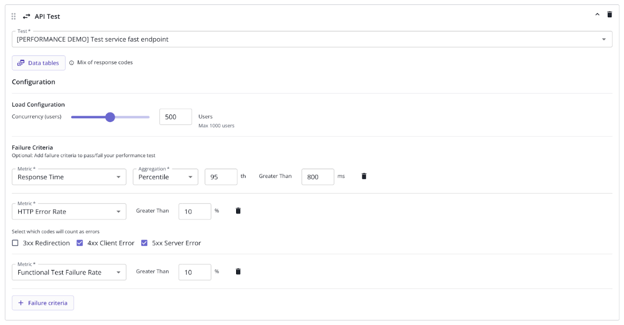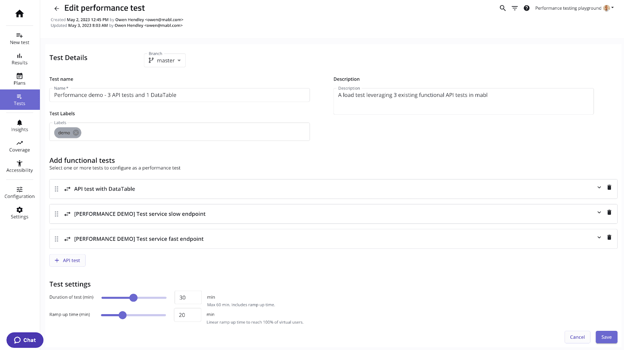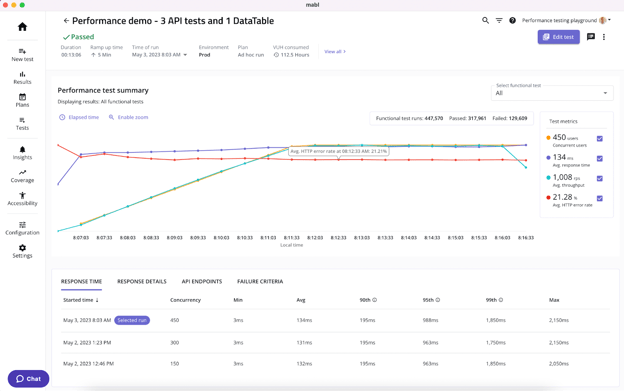Application performance has immediate and long-term impacts on customer retention and company success: a 1-second delay in page load times can hurt conversions by up to 7%, and 45% of consumers leave slow websites with a bad impression of the business. However, performance testing is typically executed on a much slower frequency than DevOps cycles, limited by high technical barriers and specialized expertise that prevents many teams from getting timely feedback during development.
This challenge is why mabl launched performance testing. Integrated into mabl’s low-code test automation platform, this capability offers a new, seamless approach to performance testing that breaks down tooling and skill barriers.
Overcoming Technical Obstacles to Performance Testing
Performance testing has been siloed away from development cycles due to the need for specialized skills and tools. Scenarios need to be defined by dedicated performance testing experts, who can typically only run tests right before releases or on a monthly/quarterly basis. Even if performance issues are discovered before deployment, they can only be investigated and fixed with a cumbersome, heavily manual process that further slows progress. This lack of flexibility alone puts performance testing at odds with a DevOps world where 75% of development teams accelerated deployment frequency in 2022. But the barriers to better performance don’t stop there.
Performance testing is typically costly and high-maintenance, straining company resources as more organizations seek to streamline operations and minimize spending. Tools often require a dedicated environment on company-managed infrastructure. Scaling requires cutting through red tape and securing additional resources, adding frustrating barriers and ensuring that routine performance testing is out of reach for many development teams. Overcoming these barriers means finding new tools that support a more routine and more collaborative approach to performance testing.
DEMOCRATIZING PERFORMANCE TESTING WITH LOW-CODE TEST AUTOMATION
Mabl’s mission is to empower more people to contribute to software testing so they can achieve fast and reliable end-to-end test coverage with 90% less effort. Low-code delivers on this mission by making test creation and maintenance a fast, intuitive process to which all team members can contribute. Regardless of experience and expertise, everyone benefits:
- Manual testers can leverage their product expertise and understanding of the customer experience to create automated tests that cover important user journeys.
- QA engineers and SDETs can scale automated test coverage by leveraging low-code for complex end-to-end journeys that might require multiple days to code with scripted frameworks.
- Developers benefit from faster feedback on code changes that may impact important user experiences earlier in development cycles. Low-code streamlines test creation so that testing becomes an easy addition to time-crunched sprint cycles.
Mabl’s low-code test automation platform makes testing a collaborative practice that enables everyone to understand product quality and the customer experience. And mabl’s new performance testing solution builds on that foundation to democratize this important type of testing and foster a more comprehensive approach to quality.
THE IMPORTANCE OF API LOAD TESTING
There are two main types of load testing: browser load testing and API load testing. Though browser load testing can provide a broader look at the user experience, it can be difficult to quickly identify the root cause of test failures. Plus browser load tests are more resource-intensive and expensive to run. API load testing, on the other hand, is substantially more efficient. It requires fewer resources to run, targets specific APIs (and backend services), and can be executed independent of browser availability.
Mabl users can quickly configure API load tests by leveraging existing mabl API tests, or by importing collections from Postman. For each selected API test, simply set the number of concurrent users to simulate those API transactions, and add one or more failure criteria based on response time, HTTP error rate, and test failure rate.

Configuring an API load test in mabl
Once all API tests have been selected and configured individually, mabl users just need to set the test duration and ramp time for the entire load test.

Setting API load test duration and ramp time
Once tests are executed, mabl provides rich load test reports that can be easily shared across the team for a shared understanding of how an application performs under load. The entire organization can easily collaborate for faster diagnostics and resolution when a performance issue is found, unlocking greater speed and confidence for every new release.

Shareable performance testing report in mabl
This new approach to performance testing eliminates the need to create and maintain separate performance test scripts, allowing teams to run performance tests more frequently or even as part of their development pipeline.
INTEGRATING PERFORMANCE TESTING INTO DEVELOPMENT PIPELINES
Running performance tests early and often can help software teams ensure that any performance degradations caused by new code changes are caught before they become expensive to fix or impact customers. But provisioning infrastructure for performance testing can be a bottleneck that prevents teams from integrating performance testing into their development pipelines.
With mabl, software teams can harness the benefits of a cloud-native infrastructure that spins up on-demand and scales seamlessly. Developers and quality teams save valuable time and effort without the need to maintain a dedicated environment or company-owned infrastructure, helping them stay focused on what matters most: building high-quality customer experiences and improving test coverage.
Mabl enables teams to run API load tests on demand, on a schedule, or as part of their CI/CD pipelines so that performance testing can match the pace of DevOps. As an organization undergoes digital transformation and matures their DevOps practices, their performance testing strategy in mabl will easily adapt.
Compete - and Win - On The Customer Experience
According to Gartner, 81% of companies are competing on the quality of their customer experience. When consumers visit an application or website, performance is a fundamental part of their experience and is extremely likely to impact if they become a customer. Breaking performance testing silos ensures that a team is prepared to win customers in a digital-first world. Plus the quality team benefits from expanding their testing skills and spending less time on infrastructure maintenance.
API load testing is now available in early access and can be requested here. Join our webinar on Wednesday, May 17th to explore the importance of API load testing and how mabl empowers development teams to use functional tests for performance testing. Save your seat.






